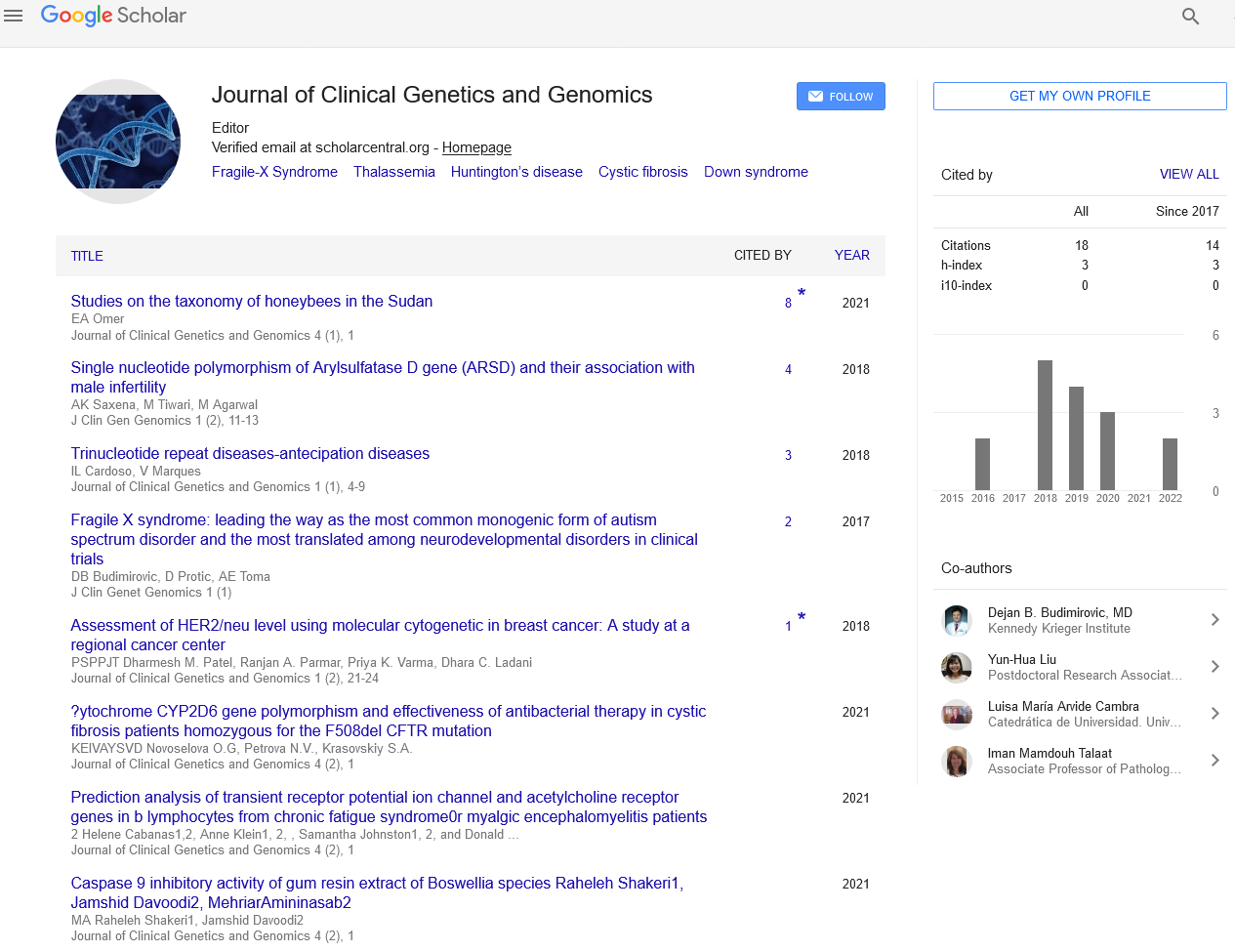Hereditary pulmonary alveolar proteinosis: Allogeneic Hematopoietic Stem Cell Transplantation Following Lung Transplantation
Received: 06-Jun-2022, Manuscript No. PULJCGG-22-5970; Editor assigned: 08-Jun-2022, Pre QC No. PULJCGG-22-5970 (PQ); Accepted Date: Jun 17, 2022; Reviewed: 12-Jun-2022 QC No. PULJCGG-22-5970 (Q); Revised: 15-Jun-2022, Manuscript No. PULJCGG-22-5970 (R); Published: 20-Jun-2022, DOI: 10.37532/puljcgg.22.5(3) 1-2
Citation: Amis M. Hereditary pulmonary alveolar proteinosis: Allogeneic hematopoietic stem cell transplantation following lung transplantation J. Clin.Genet. Genom. 2022;5(3):1-2.
This open-access article is distributed under the terms of the Creative Commons Attribution Non-Commercial License (CC BY-NC) (http://creativecommons.org/licenses/by-nc/4.0/), which permits reuse, distribution and reproduction of the article, provided that the original work is properly cited and the reuse is restricted to noncommercial purposes. For commercial reuse, contact reprints@pulsus.com
Abstract
A rare, widespread lung condition known as Pulmonary Alveolar Proteinosis (PAP) is characterised by surfactant buildup in the small airways as a result of suboptimal alveolar macrophage clearance, impairing gas exchange. The current gold standard of care for PAP is whole lung lavage. When whole lung lavage or other experimental therapy approaches are inadequate or in cases of severe pulmonary fibrosis brought on by PAP, lung transplantation is a recognised alternative for treatment. Recurrence of PAP in the transplanted lungs, especially in hereditary PAP, is a drawback of lung transplantation. The Granulocyte Macrophage-Colony Stimulating Factor (GM-CSF) receptor genes are the source of the genetic abnormalities that lead to the hereditary form of PAP, an extremely rare illness that directly affects bone marrow-derived monocytes that later develop into macrophages in the lung. As a result, these macrophages frequently exhibit faulty GM-CSF receptor signalling, which impairs surfactant clearance. In cases of hereditary PAP, a bone marrow or hematopoietic stem cell transplant may be able to cure the pulmonary condition. Theoretically, hematopoietic stem cell transplantation after lung transplantation could prevent post-lung transplant PAP recurrence in patients with hereditary PAP, which would enhance long-term outcomes because it causes a graft-versus-disease (PAP) effect. We discuss a rare case of end-stage respiratory failure brought on by hereditary PAP-induced pulmonary fibrosis that was effectively treated with bilateral lung transplantation and a subsequent allogeneic hematopoietic stem cell transplant. In selected patients with end-stage hereditary PAP, our findings recommend treatment with serial lung and hematopoietic stem cell transplantation to enhance quality of life and lengthen survival without PAP recurrence.
Key Words
Hematopoietic; Transplantation; Pulmonary condition; alveolar proteinosis ; Macrophages
Introduction
A rare, widespread lung condition known as Pulmonary Alveolar Proteinosis (PAP) is characterised by surfactant buildup in the small airways. A high level of autoantibodies against GranulocyteMacrophage Colony-Stimulating Factor (GM-CSF) negate the biologic action of GM-CSF, resulting in inadequate surfactant clearance in PAP cases, which have an incidence of 6-7 cases per million people worldwide. Hereditary PAP, which is regarded as the prototypical case of an ultra-rare disease, is caused by mutations in the heterodimeric GM-CSF receptor or chains (CSF2RA, CSF2RB), the surfactant. Alveolar macrophages exhibit decreased surfactant clearance in the absence of GM-CSF or in the event of interrupted GM-CSF receptorsignaling, which accumulates and inhibits alveolar gas exchange. On the other hand, secondary PAP is brought on by an underlying illness that affects the function of alveolar macrophages, including problems with surfactant degradation. These include immune deficiency disorders, cancers, infectious diseases, haematological problems, and exposure to hazardous inhalants.
PAP is identified based on a compatible medical history, characteristic radiologic findings, the outcomes of lung biopsies and/or bronchoalveolar lavage cytology, and compatible biomarkers. PAP's non-specific clinical presentation can vary in intensity and clinical appearance. Early diagnosis is frequently delayed for months or even years due to the disease's sneaky beginnings. Exertional dyspnea, cough, exhaustion, and weight loss are typical symptoms. A first, noninvasive diagnostic technique that can identify PAP in about 90% of patients is serum GM-CSF antibody testing. With a compatible medical history and common imaging results, this method removes the necessity for an intrusive surgery like a lung biopsy. In the mid and lower lung regions of a chest radiograph, bilateral symmetrical opacities are typical. The presence of thicker intralobular structures and interlobular septa in typical polygonal patterns overlaid on ground glass opacities, sometimes known as "crazy-paving," are classic hallmarks of high resolution computed tomography. There is a lot of PAS-positive proteinaceous material in and around alveolar macrophages, which is evident in the milky, turbid appearance and heavy sediment of bronchoalveolar lavage fluid. A restrictive ventilatory deficit may be present alone or in conjunction with a reduction in the diffusing capacity for carbon monoxide, as shown by pulmonary function tests. Anti-GM-CSF antibodies are found in autoimmune PAP, in contrast to hereditary PAP, where defective GM-CSF receptor function is confirmed by genetic sequencing to be caused by recessive genetic variations. Additional laboratory testing is necessary only if secondary PAP-causing factors have been ruled out. The presence of amorphous, Periodic Acid-Schiff (PAS)-positive lipoproteinaceous material (surfactant) in the terminal bronchioles and alveoli on transbronchial or surgical biopsy serves as the basis for the diagnosis of PAP.
Due to decreased alveolar gas exchange and/or fibrotic progression of PAP, primary PAP will cause respiratory insufficiency and death if untreated or in the event of inadequate treatment. However, extensive interstitial fibrotic illness extremely rarely affects PAP patients. Lung transplantation may be a viable medical option for these individuals to enhance quality of life and lengthen longevity. Recurrence of PAP in the transplanted lungs, particularly in hereditary PAP, is a drawback of lung transplantation. This is because recipient (GM-CSF receptor-deficient) monocyte-derived alveolar macrophages gradually replace donor alveolar macrophages in the years after lung transplantation, despite recent reports of long-term persistence of donor alveolar macrophages.





